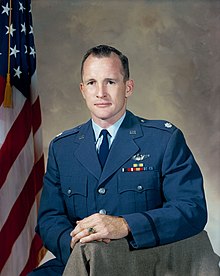Edward Higgins White
| Edward Higgins White | |
|---|---|
 | |
| NASA Astronaut | |
| Statsborger | USA |
| Nationalitet | Amerikaner |
| Status | † Afdød |
| Født | 14. november 1930 San Antonio, Texas |
| Død | 27. januar 1967 (36 år) Cape Canaveral Air Force Station, Florida, USA |
| Gravsted | West Point Cemetery |
Andet arbejde | Testpilot |
| Uddannelses- sted | University of Michigan U.S. Air Force Test Pilot School West Point |
| Rang | Oberstløjtnant, US Air Force. |
Tid i rummet | 4 dage 1 time |
| Udvælgelse | Astronautgruppe 1962 |
| Mission(er) | Gemini 4, Apollo 1 |
| Missionsemblemer | |
Edward Higgins White II (14. november 1930 i San Antonio, Texas – 27. januar 1967), var en amerikansk testpilot og astronaut.
Edward White gjorde historie da han som første amerikaner gennemførte en rumvandring fra rumskibet Gemini 4.
White døde i en katastrofal brand om bord på rumfartøjet Apollo 1, under en test på jorden. Branden dræbte alle tre astronauter om bord.
Hædersbevisninger efter sin død
White blev tildelt the Congressional Space Medal of Honor 30 år efter sin død.
Sent i 1967 blev White æret med et amerikansk frimærke, selv om hans navn ikke blev nævnt. Frimærket viste hans rumvandring.[1]
Den 27. januar 2004 besluttede NASA sig for at minde mandskabet på Apollo 1, ved at navngive tre marsbjerge nord for "Columbia Memorial Station" Apollo 1 Hills. De tre astronauter fik hver opkaldt et bjerg efter sig: Grissom Hill, Chaffee Hill og White Hill. Den Internationale Astronomiske Union har endnu ikke officielt bekræftet navnene på disse bjerge.
Astronaut Edward White under den første amerikanske rumvandring, udført på Gemini 4-missionen.
Referencer
- ^ "Gemini Space Walk". Arkiveret fra originalen 17. januar 2008. Hentet 13. december 2007.
Eksterne henvisninger
- NASAs biografi om White Arkiveret 17. oktober 2018 hos Wayback Machine
|
Medier brugt på denne side
Astronaut Edward H. White II, pilot for NASA's Gemini IV mission is shown in the crews ready room at Launch Complex 16, suited and ready to ride the van to Launch Complex 19 for insertion in the spacecraft. The Gemini IV flight was launched at 10:16 am EST on June 3, 1965. The objective of the Gemini IV mission was to evaluate and test the effects of four days in space on the crew, equipment, and control systems. White successfully accomplished the first U.S. spacewalk during the Gemini IV mission.
On June 3, 1965 Edward H. White II became the first American to step outside his spacecraft and let go, effectively setting himself adrift in the zero gravity of space. For 23 minutes White floated and maneuvered himself around the Gemini spacecraft while logging 6500 miles during his orbital stroll. White was attached to the spacecraft by a 25 foot umbilical line and a 23-ft. tether line, both wrapped in gold tape to form one cord. In his right hand White carries a Hand Held Self Maneuvering Unit (HHSMU) which is used to move about the weightless environment of space. The visor of his helmet is gold plated to protect him from the unfiltered rays of the sun.
The photo camera in front of White is a Zeiss Contarex 35 mm (Source for camera type: NASA website).
Gemini 4 patch
This is the insignia for the National Aeronautics and Space Administration's (NASA) Apollo 1 mission, the first manned Apollo flight. Crew members are astronauts Virgil I. Grissom, Edward H. White II and Roger B. Chaffee.
Title: Astronaut Edward White during first [American] EVA performed during Gemini 4 flight Description: Astronaut Edward H. White II, pilot for the Gemini-Titan 4 space flight, floats in zero gravity of space. The extravehicular activity was performed during the third revolution of the Gemini 4 spacecraft. White is attached to the spacecraft by a 25-ft. umbilical line and a 23-ft. tether line, both wrapped in gold tape to form one cord. In his right hand White carries a Hand-Held Self-Maneuvering Unit (HHSMU). The visor of his helmet is gold plated to protect him from the unfiltered rays of the sun.
Astronaut Edward H. White II (United States Air Force Lieutenant Colonel), Gemini 4 pilot. Editor's Note: Since this portrait was taken astronaut White lost his life on Jan. 27, 1967, in the Apollo 1/Saturn 204 fire at Cape Kennedy, KSC, Florida.









